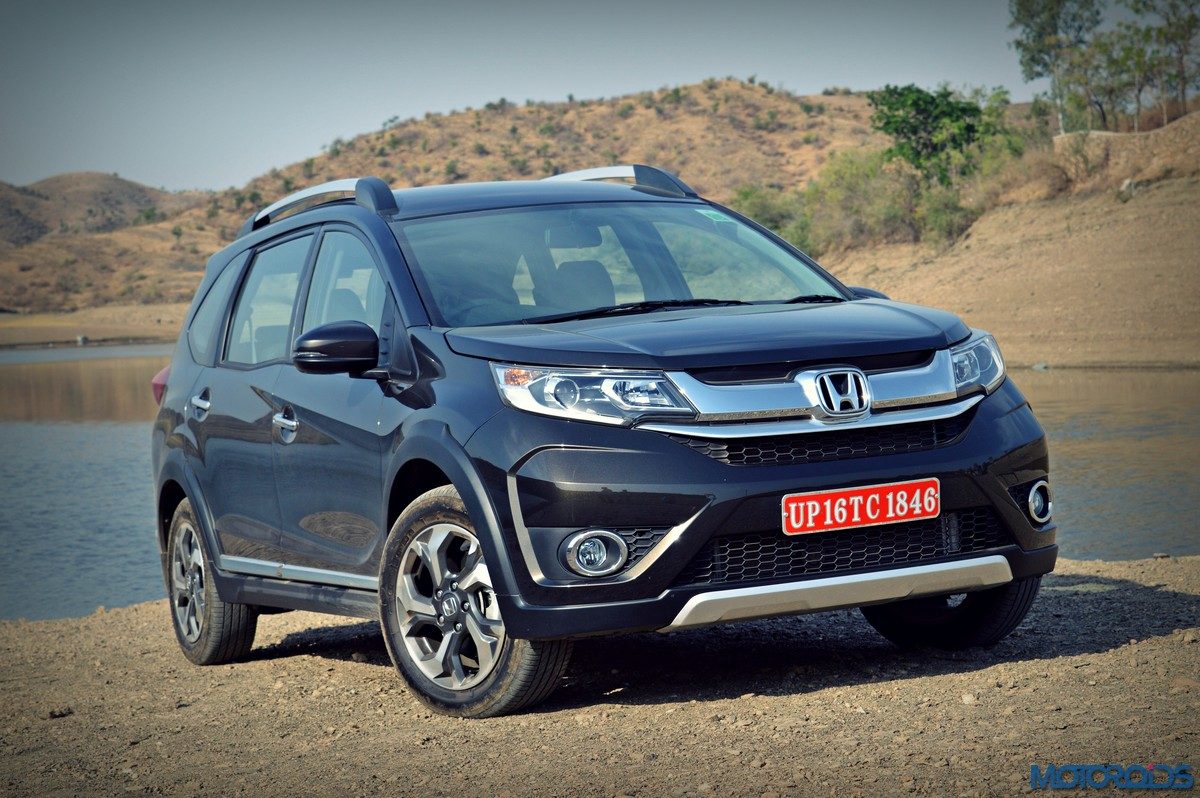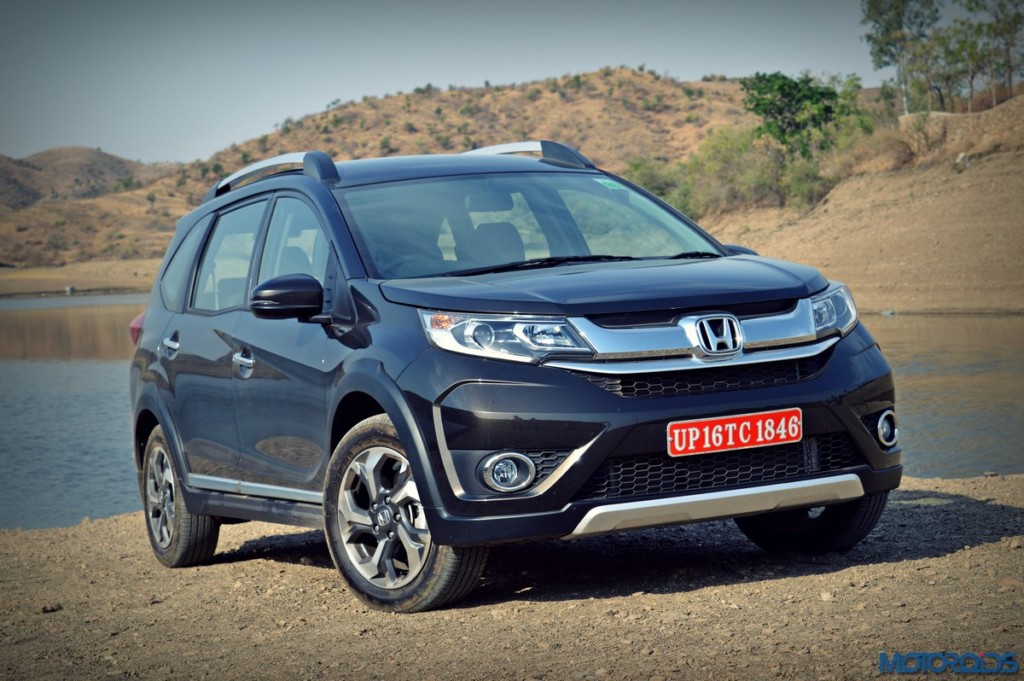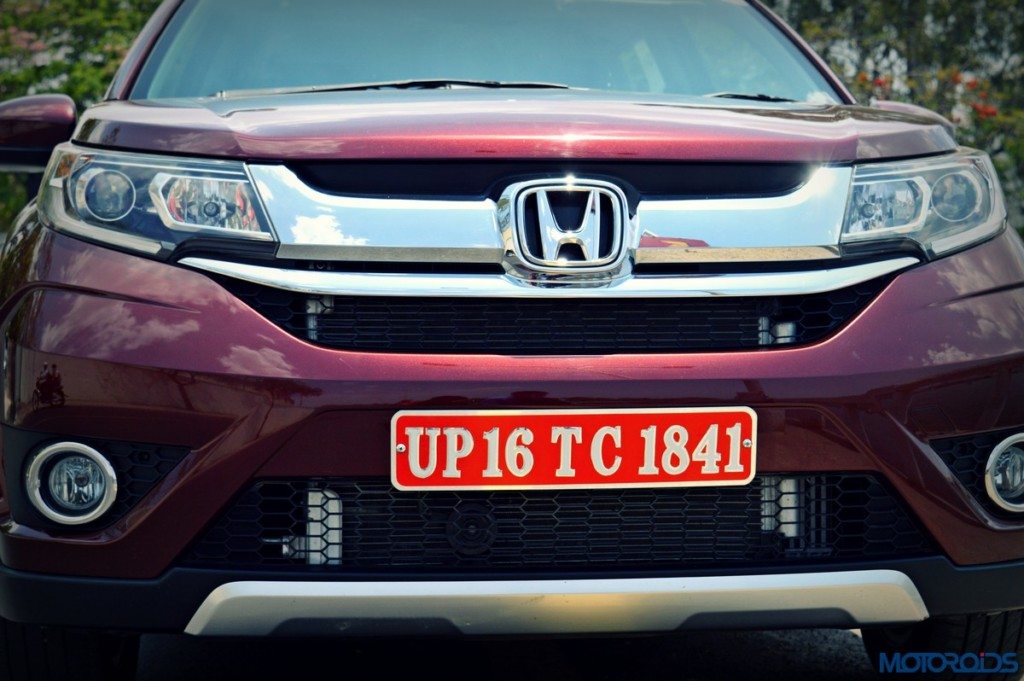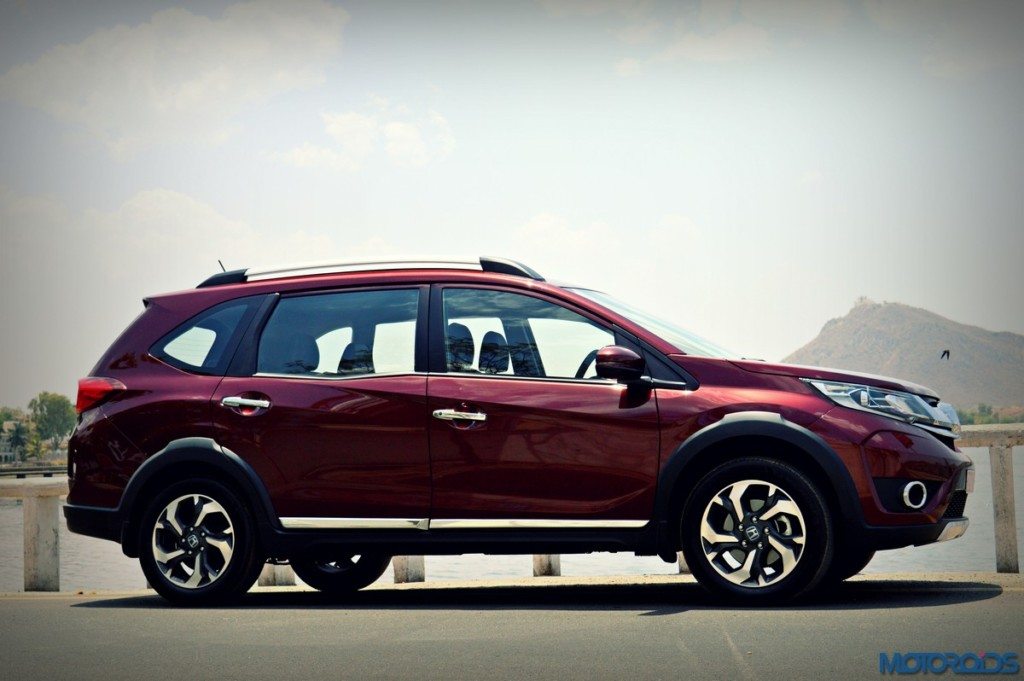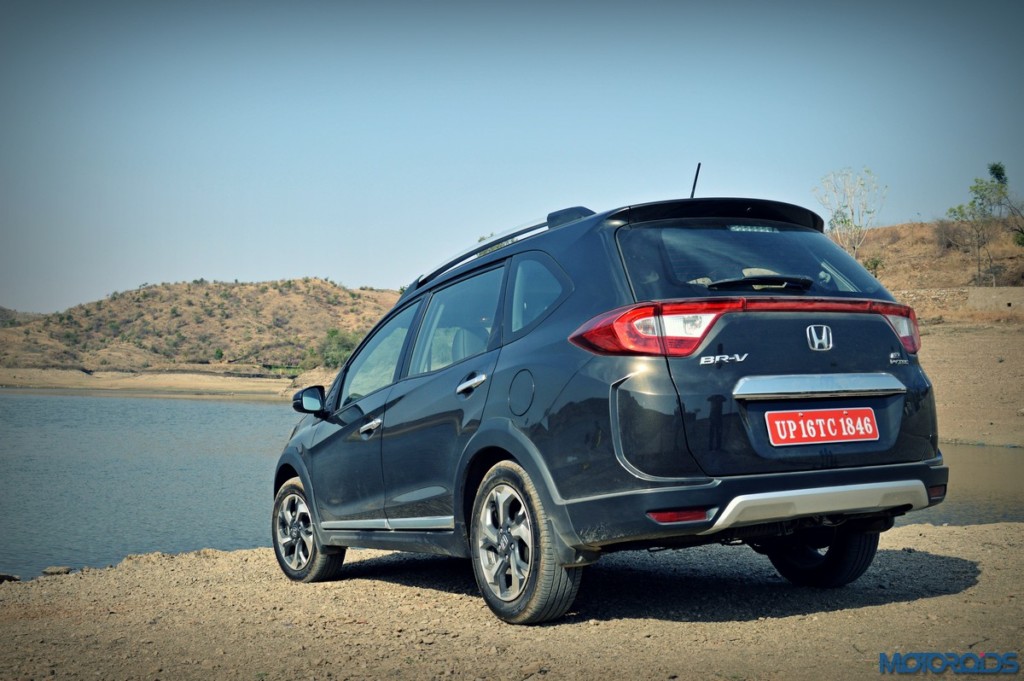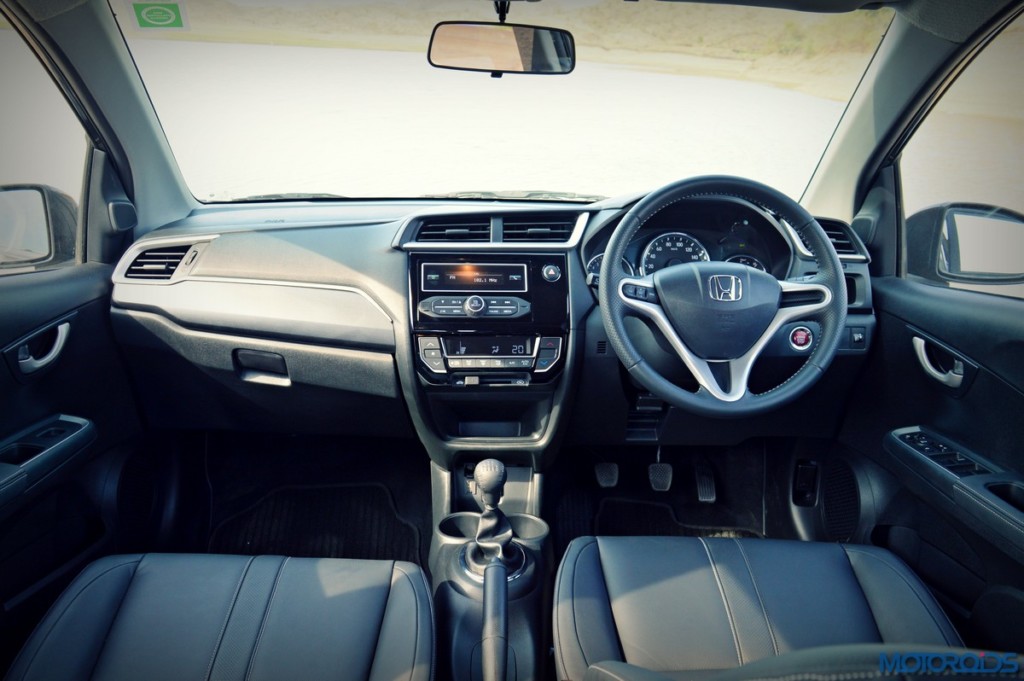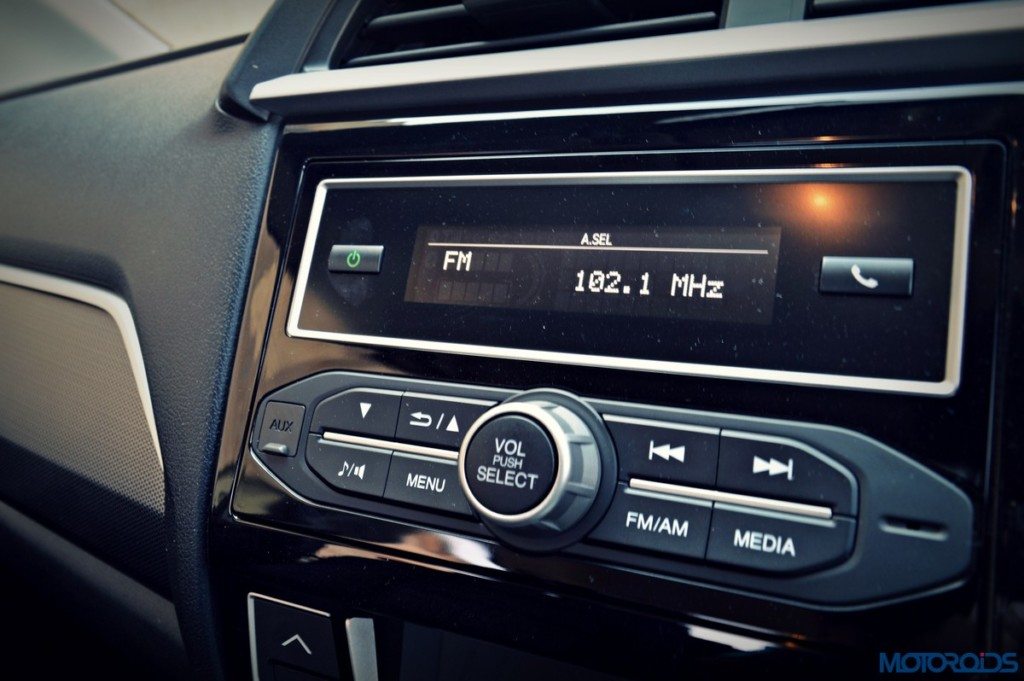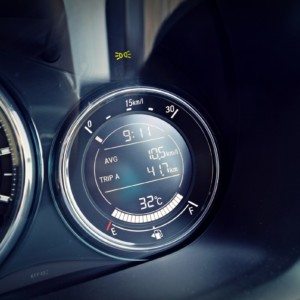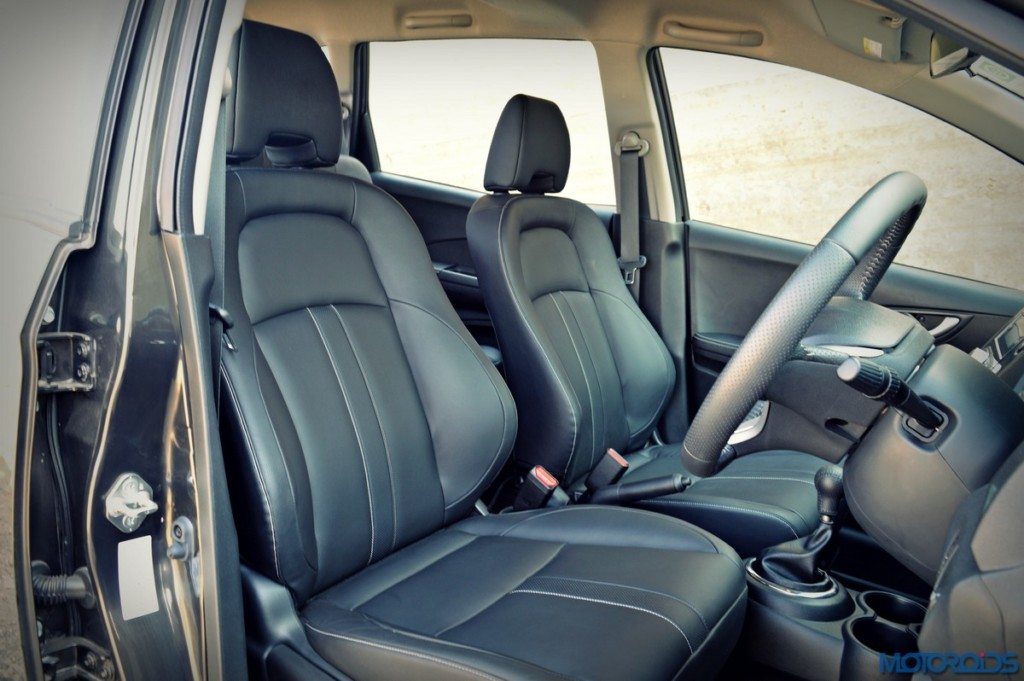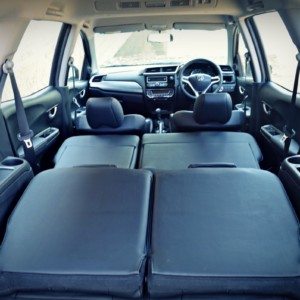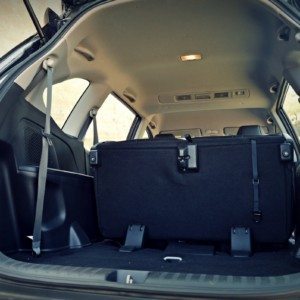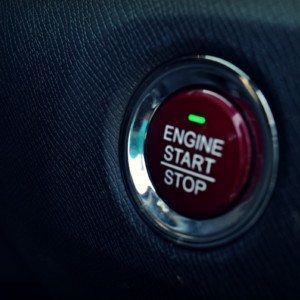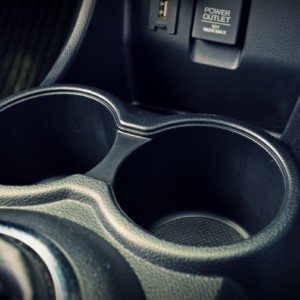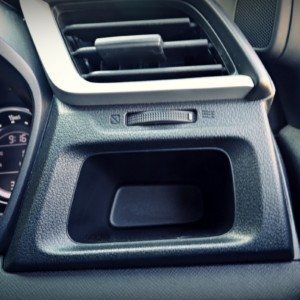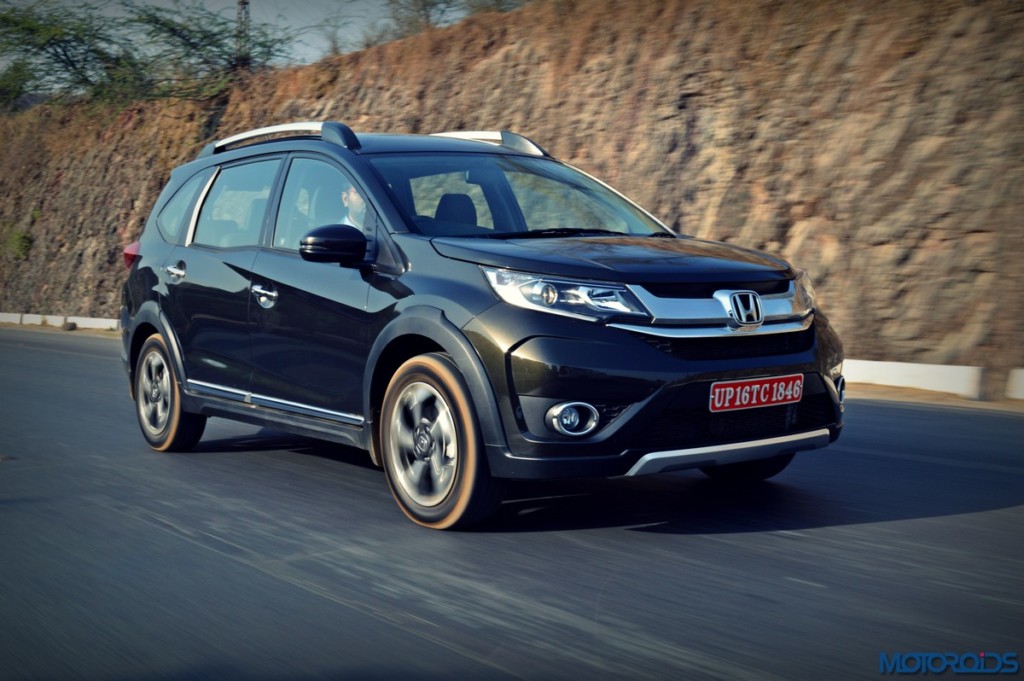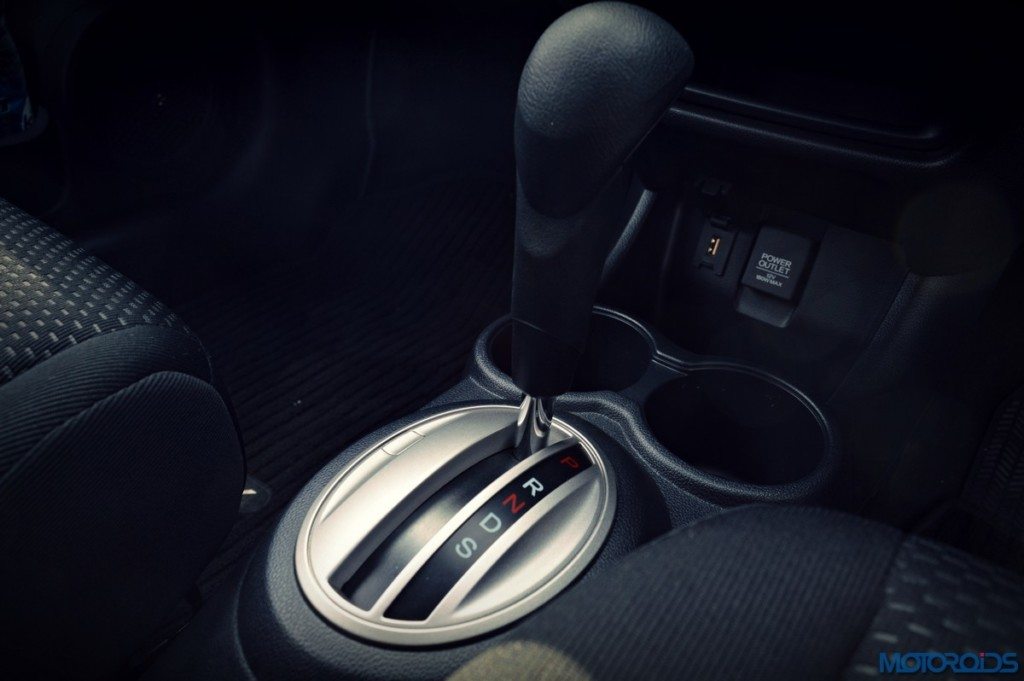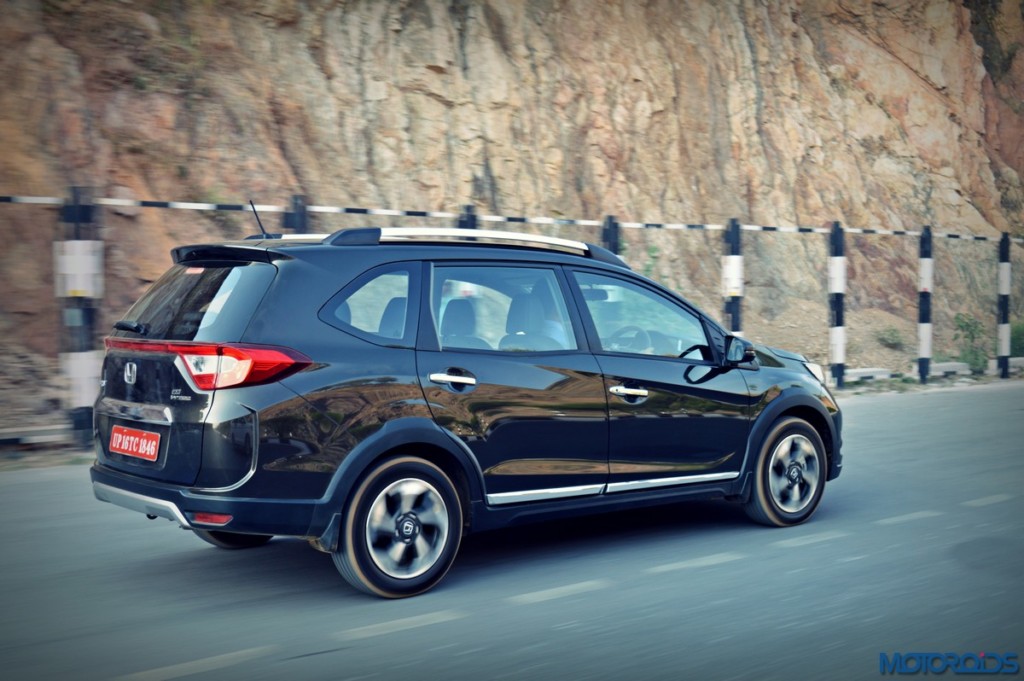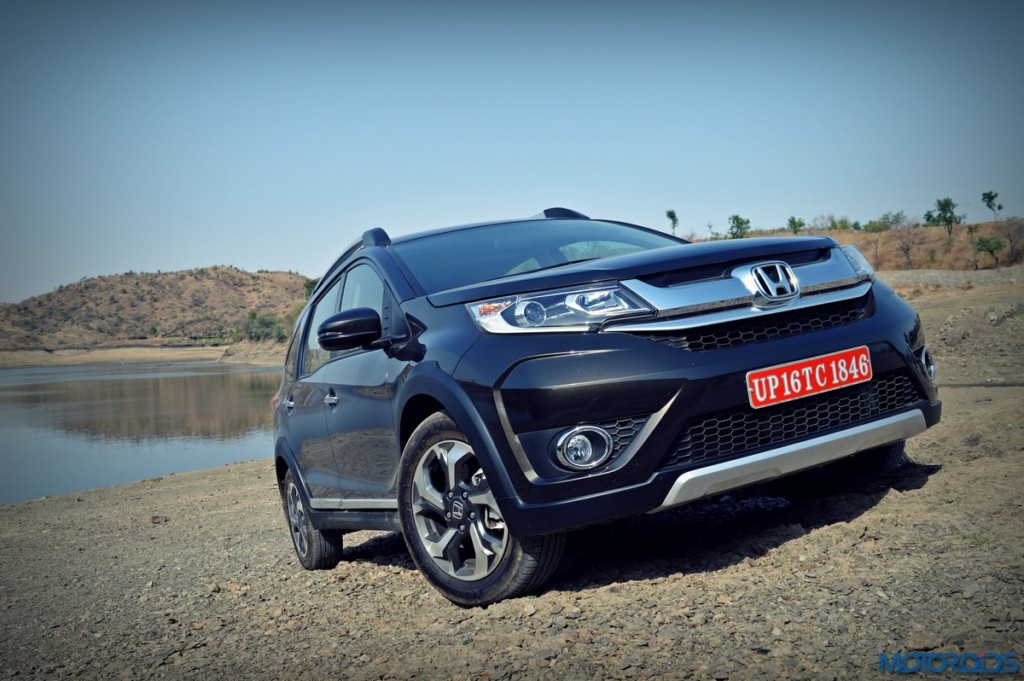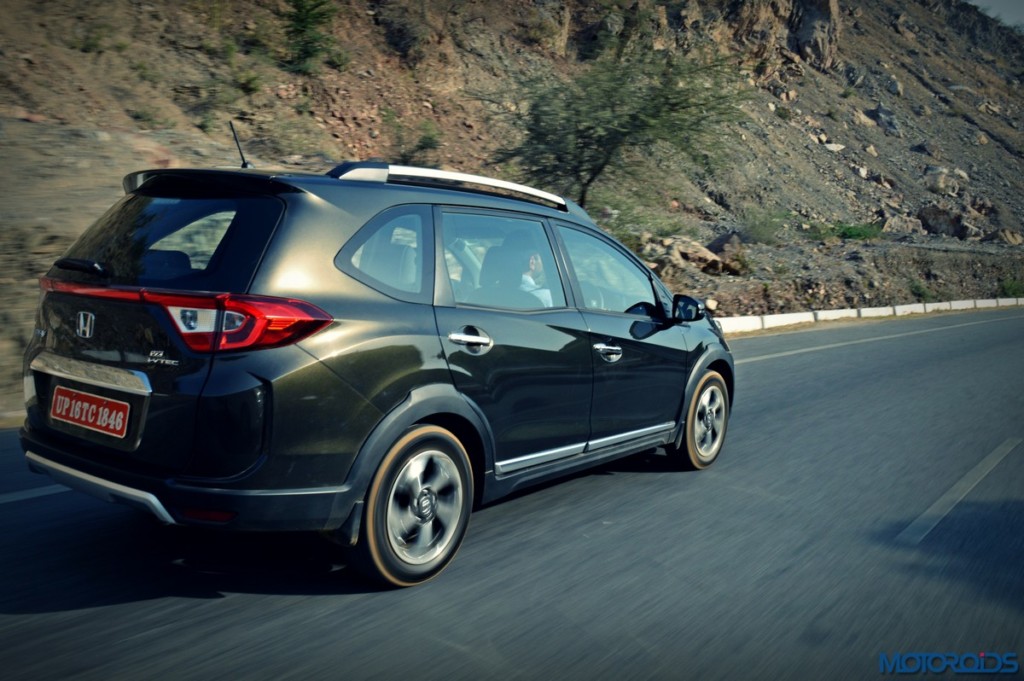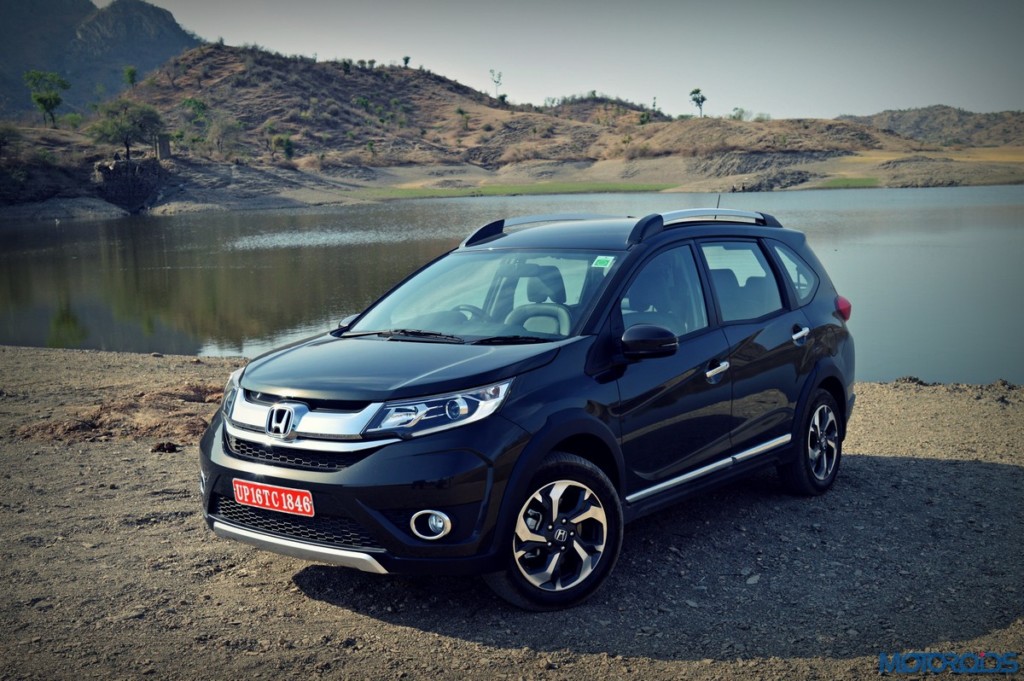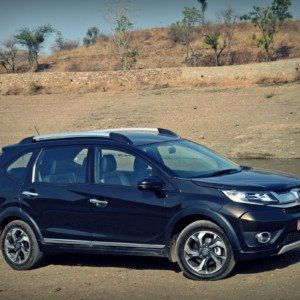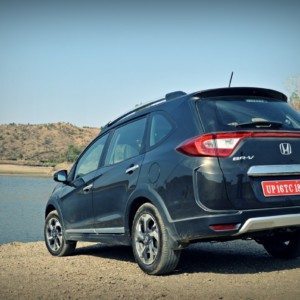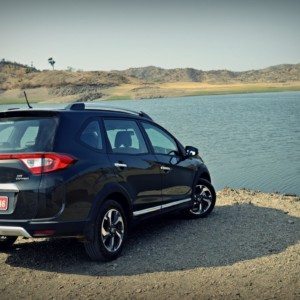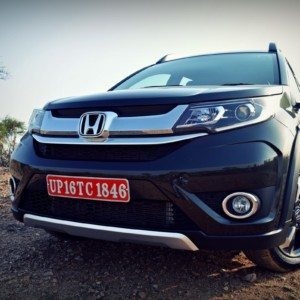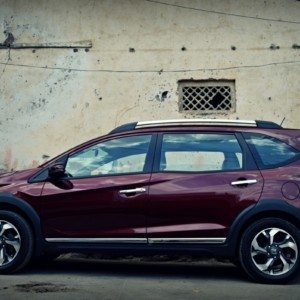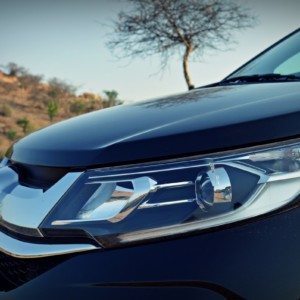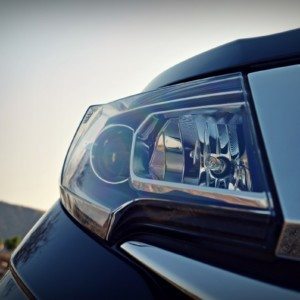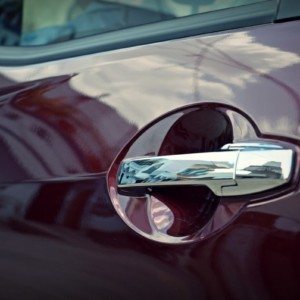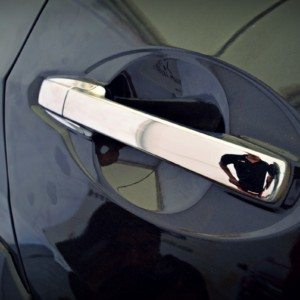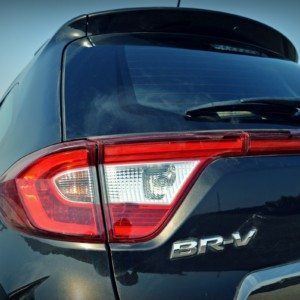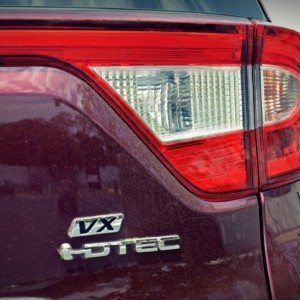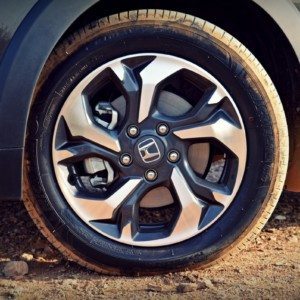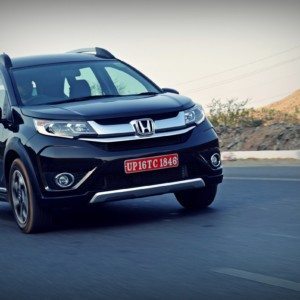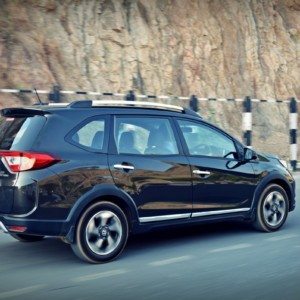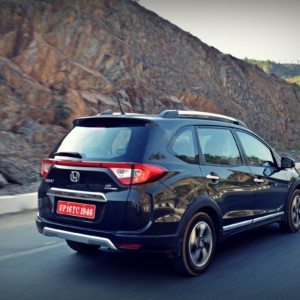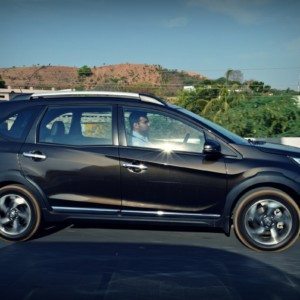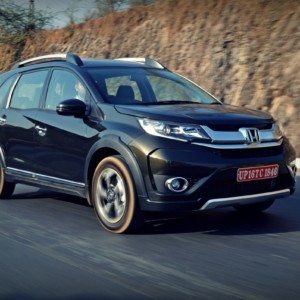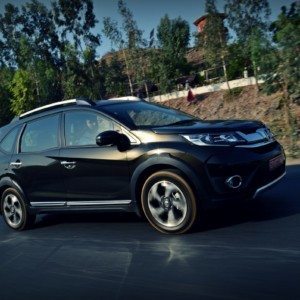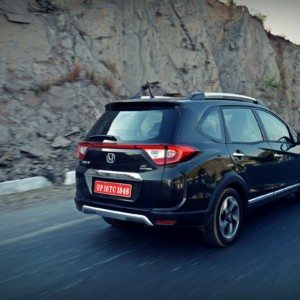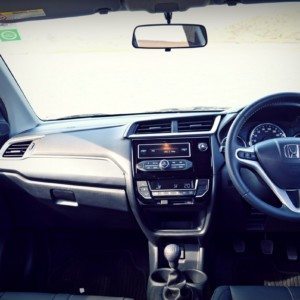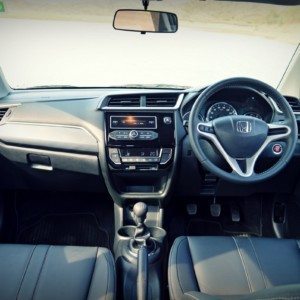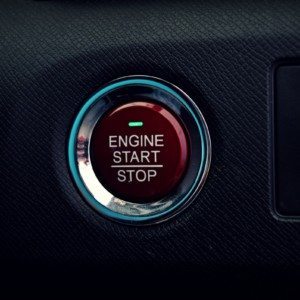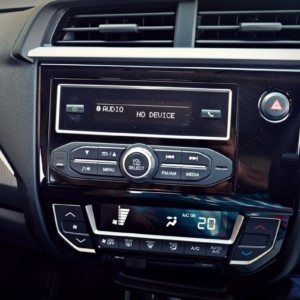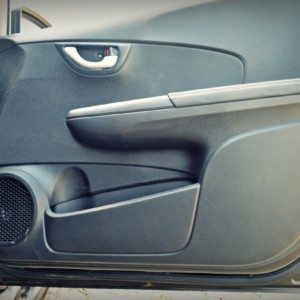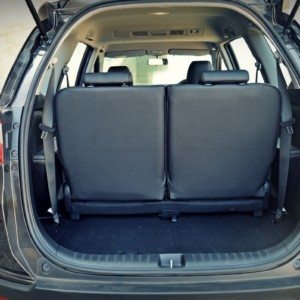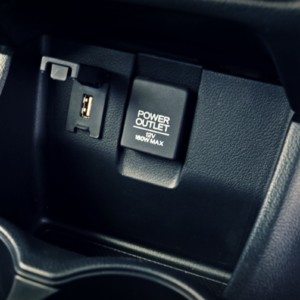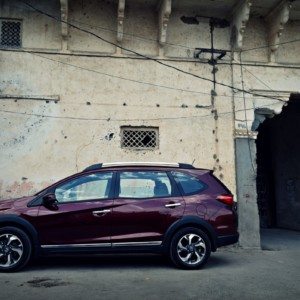NASA’s Curiousity Rover has started its treacherous 7.5 km hike on Mars with ferocious intent, aiming for possible mineral deposits that might uncloak some of the red planet’s mysteries. Back home on Earth, India to be specific, every hatchback or compact sedan owner is realigning their finances with similarly ferocious intent, aiming to buy a SUV as their next car. The Hyundai Creta is making the most of this syndrome, and so is the new Vitara Brezza by Maruti. Honda, not to be left behind has re-armed its product onslaught for India with the eagerly anticipated BR-V compact SUV. The BR-V rounds off Honda India’s portfolio, which was desperately missing a high-riding vehicle for the masses. We spent some time with the Honda BR-V in sultry Rajasthan, getting a taste of the Japanese manufacturer’s latest entrant in the Indian market.
Honda BR-V Appearance
It’s more than just a jacked up Mobilio. No really.With its shiny face, chrome streaked wheels, and jewelled headlamps, the BR-V gives off a distinctly posh vibe, something that’ll make the Mobilio sneer at it. That’s because unless you’ve ordered your Mobilio with the RS kit, the BR-V is the one that’ll be getting more stares.
As compared to the Mobilio, the BR-V gets a thoroughly revised face that even manages to create a two-boxed appearance in profile, rather than the Mobolio’s MPV-like, mono-box volume. There’s Honda’s new H-face, which involves a thick chrome slat underlined with a thin one, along with crisply detailed headlamp units with projector illumination and LED light guides. The large front bumper gets a two-part grille with mesh inserts and round fog lamps outlined with chrome, while a front skid plate ups the SUV quotient somewhat.
The resemblance to the Mobilio is laid bare on the sides, with the familiar kink in the window line being the most notable giveaway. Things are however spruced up with chrome finishers below the doors, and smart body cladding with small plateaus on top of the wheel arches. Again, familiar slashes of bodywork on the doors also visually link it to the Mobilio, and its length. In fact, the BR-V is so long that it manages to make its 210 mm strong ground clearance feel like a hairline fracture. Which mind, you is a figure only matched, not usurped, by the Renault Duster AWD. In fact, it is so long that, at 4456 mm, it stretches more than 14 centimeters longer than its nearest rival, again, the Renault Duster.
From the back, only the rear screen and the integrated spoiler above it give away its Mobilio roots. Below lays horizontally aligned tail lamps which are bridged by a slim reflective strip that also marks the bottom of the rear screen. The rear bumper also features an integrated, dull silver finished skid plate to keep those SUV ambitions high, while chunky roof rails are also present with the same intent.
Honda BR-V Interiors
Inside, the dashboard is a dead-ringer for the one found in the face-lifted Amaze, replete with the dull silver slivers slicing across. Except, for the BR-V, it gets an all-black color scheme, while, apart from the steering wheel and gear knob, everything is exactly similar to the new Amaze’s job, right down to the two bottle holders and the entire floor console. Oh, the lower portion of the BR-V’s dashboard facing the front passenger also gets a new texture to add a whiff of class. The top-end variants come equipped with black leather upholstered seats and adjustable headrests for all seven seats. There’s leather on the steering wheel, gear knob and the arm rests on the doors.
The piano black accented center console, like on the Amaze doesn’t feature a touch screen equipped infotainment system, which is a glaring omission in this segment. Instead, it gets an integrated unit with Bluetooth audio streaming, and radio, apart from USB, Aux-in and smart phone connectivity. Sound quality from the six speakers is average. Below the infotainment system lie the automatic air conditioning controls, which are shared with the Amaze as well.
The BR-V, however, gets a different steering wheel which sets it apart from its lesser endowed cousins. This wheel, last seen on the previous generation Jazz definitely feels richer than the ones in the Brio, Mobilio and the Amaze. Behind the new wheel lies the Amaze-like instrument cluster with its large, legible dials and the trip computer which also shows instantaneous and average fuel economy readings, outside temperature, and the time.
The front seats are well bolstered and accommodate the average Indian in relative comfort, and as for space, there’s enough of it for his/her head and feet, except transversely. You see, inside, space wise, it’s the Mobilio all over again, so things are a bit narrow. To put it in numbers, the BR-V is significantly narrower (1,735 mm) than both the Renault Duster (1,822 mm) and the Hyundai Creta (1,780 mm). This reflects inside as well, more so in the second row, which finds it a bit of a squeeze to accommodate three adults abreast, making the BR-V more of a six-seater in the real world. In the front, if both the driver and you are on the heavier side, you’d be rubbing each other’s elbows, which isn’t a surprise considering the BR-V’s roots can be tracked down all the way down to the Brio super-mini.
The class-leading length and the voluminous, MPV-derived cabin, however, ensure that both head- and leg-room aren’t a cause for concern for the second row occupants, who also get an integrated arm-rest. Under thigh support isn’t the best however, and the relatively flat second row seats are to be blamed. The large windows make the cabin airy as well, while the wide doors and the second seats, which come with a 60:40 split, tumble down at the touch of a lever, allow for a comfortable ingress to the third row. The rear most seats are a bit upright, very flat and feature a 50:50 split, but surprisingly comfortable. Obviously, legroom here isn’t as generous as in the second row, but it isn’t cramped either, and I, who stands 5 feet 9 inches tall can comfortable spend a couple of hours there, without my knees kissing my chin, and enjoy my drink in my dedicated bottle holder. Also, the large rear window doesn’t spoil the rolling views outside either.
The BR-V is the only SUV in its class to offer top-mounted AC vents, a feature borrowed from the Mobilio MPV. This adds to the comfort of the rear seat passengers without reducing legroom, unlike how floor mounted units always get in the way. Boot space is rated 223 litres with all three rows in place, which isn’t bad at all. If you are travelling full house, however, the boot will barely accommodate a few backpacks. Tuck the third row away, and you have a cavernous 691 litres of space at your disposal.
As for features, the BR-V might make the Indian consumerist feel wanting for a bit more. Apart from a touch screen and navigation, the BR-V misses out on the parking sensors, reverse parking camera and even auto headlamps and wipers. There’s only one 12V charging socket inside. Notable and appreciable features include a push button start, several cubby holes on the dashboard, 1-litre bottle holders on the door pads and a couple of cup holders.
Honda BR-V Power
Being based on the same platform that underpins the Brio, the BR-V is front wheel driven, with no provision for accommodating an all-wheel-drive setup. Petrol power for the BR-V comes from the same 1.5-liter i-VTEC engine shared with the City, and is rated at 117 bhp and 145 Nm of torque. The petrol engine is now matched to a newly developed 6-speed manual transmission, and the new package is the pick of the lot if you love to drive. The newly developed transmission has significantly bettered the character of the familiar engine, with its altered ratios allowing it to tap the engine’s torque much more readily as compared to the erstwhile 5-speed job, especially in the lower gears.
For starters, the tractability has significantly increased, and with this new 6-speed transmission, the BR-V petrol can now effortlessly potter around at ridiculously low speeds of 20 km/h in fourth gear. This results in lesser downshifts in traffic ridden conditions, which in turn, results in better fuel efficiency – Honda claims an impressive 16 km/l, but expect real world figures to be a bit shy of that figure. Then there’s the straight line grunt, which is smooth and linear (but not particularly punchy), as the naturally aspirated petrol engine spins cleanly. In fact, acceleration times have also increased a tad, but it’s the improved drivability that matters the most here. The short throws of the new stick are delightfully crisp and precise, while clutch action is light and pleasing.
I like the way the motor sounds too – a very throaty gnarl that bounces off the rev-limiter at 7,000 rpm. Though sedate driving manners will not spur the engine noise to filter into the cabin, spirited motoring renders the cabin with engine noise, which can be delightful for an enthusiast, but may get a bit irksome if you’re a sedate commuter travelling from point A to point B.
The petrol engine also comes mated with an optional CVT with paddle shifters as well, the transmission type (CVT, mind, not auto) being a first for its segment. This well-behaved package is perfect for commutes that are jaded with bumper-to-bumper traffic. Be a little enthusiastic with the right foot though, and the engine groans in protest. Ambling around town in D mode is the BR-V with CVT’s forte.
There’s even an S mode, as well as the aforementioned paddle shifters, which put to use seven ratios to make it feel like the CVT has gears. This feature makes the BR-V with CVT more pleasant to drive enthusiastically rather than just seeing the tachometer needle climb relatively slowly and the engine groan in the ‘one geared’ mode. It tricks you into believing that it’s a conventional automatic transmission for some part, but push it really hard, demand quick downshifts and the relatively slower CVT with its somewhat elastic character gives itself away. The matte aluminum finished paddles shift ratios with a definitive click, and feel nice to the touch. Shift times in manual mode are reasonably quick, and make the experience moderately enjoyable, considering it’s a CVT.
The diesel engine is the usual 1.5-litre i-DTEC motor found in the Amaze, Jazz and the Mobilio; good for 98.6 bhp and 200 Nm of torque, and strapped to a 5-speed manual transmission. For the BR-V, NVH levels are toned down significantly, as there are sound insulators on the doors, under the hood and even on the floor. Engine noise is not intrusive at all, and in fact, the petrol powered version leaves more to be desired in this aspect.
Performance is carefully honed for tractability and making the power accessible throughout the band. The diesel MT, though not as tractable as its petrol sibling, is fantastic at tackling low speeds in high gears as compared to what the competition has to offer. There isn’t a discernible punch to the performance, but nor is there any lethargy. In fact, the torque curve beyond 2000 rpm is as flat as a plateau. When it comes to fuel efficiency, the i-DTEC is known to deliver and even in the BR-V, it doesn’t disappoint. Drive with a light foot, and the dirty fuel sipping BR-V will effortlessly deliver upwards of 20 km/l in real world conditions. Buy this one only and only if you’re a fuel economy freak and have incredibly long commutes. All the versions also come with an Eco mode indicator, which lights up in acknowledgement if you’re driving sedately to conserve fuel.
Honda BR-V Dynamics
The BR-V is very well behaved on the road, and rides rather nicely. The suspension is well damped, and strikes a really good balance between being absorbent and firm. Only but the biggest of pot holes and harshest of expansion joints makes their presence felt. The BR-V’s length, however, makes it lose a wee bit of its composure when tackling undulations on the road at speed. The 210 mm of ground clearance is a boon, as the BR-V stops at nothing on the road, and even impressed us thoroughly when we took it around for a mild off-road adventure.
The steering is delightfully light at low speeds, and coupled with its slim body, makes the BR-V sneak into gaps in traffic like no other high-riding vehicle. Manoeuvrability around town is brilliant, but the train-like length means that the turning radius is a wide 5.3 meters, which shoots up all the way to 5.5 meters for the diesel version. The steering also weighs up nicely with speed, and given the compliant suspension, makes the BR-V a predictable, sure-footed handler. Body roll is well contained, and only when pushed really hard around the bends, does the BR-V yaw a bit more than expected with some degree of understeer also kicking in.
Braking duties are taken care of by disc brakes at the front, and drums at the rear, assisted by ABS and EBD. Braking power is just about adequate, and the BR-V doesn’t nose dive a lot under heavy braking and manages to maintain its line as well. Safety is taken care of by dual air-bags that are standard across the range. The BR-V with twin air-bags and ABS that’s sold in Indonesia has managed to score 4 stars in the ASEAN NCAP crash test ratings, while managing a commendable 5 stars with the ESP feature that isn’t available on versions sold in India. The BR-V will be sold in eight grades, out of which half will be petrol fuelled and the other half diesel fuelled.
Honda BR-V Verdict
The Honda BR-V does most things right – it manages to look premium, with its ornamentation somewhat managing to hide its MPV/hatchback/compact sedan roots. The interiors have a great ambience, are voluminous, but struggle to accommodate seven adults due to its lack of width, while the lack of key features like a touch-screen and navigation does tend to make it a bit under-equipped in its field. The BR-V’s tried and tested engines are great, while offering good real world performance, as well as delivering terrific fuel efficiency figures. The new 6-speed transmission is a joy to row, and makes the most out of the potent petrol engine, while the affable dynamics and good ground clearance make it very friendly for Indian roads. On paper, its only shortcomings I see at the moment is the dearth of premium features and that lack of shoulder room in the second row. But will it be able to re-kindle the magic of the Hyundai Creta? Only time will tell. That said, prices are still TBA, so watch this space after tomorrow.
Honda BR-V Image Gallery

